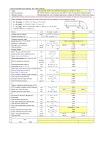Butterfly Valve vs Ball Valve
Choosing the correct valve for your application is an important task when designing a process system. Generally, each valve type's properties and characteristics make it straight-forward to decide which is best suited for a particular function. However, for specific applications, multiple different valve types may work. Therefore, it is essential to know what type of valve will suit your specific application.Ball valves and butterfly valves have several characteristics in common, including:
- They’re both quarter-turn rotary valves, requiring a 90-degree turn from open to close.
- Both are typically made from a combination of cast iron, stainless steel and brass.
- Each valve is effective for regulating the flow of most types of gas and liquid at a wide range of temperatures.
- They both are relatively inexpensive, long-lasting and dependable.
- Ball valves and butterfly valves are both easily available through a valve distributor.
With so many similarities, you’ll have to look at their differences to determine which type of valve would work best for a specific project. Here’s a look at how ball valves and butterfly valves differ from one another and how it affects their uses
|
|
Butterfly valve | Ball valve |
| Weight | Lighter weight even at larger pipe diameters | Very heavy at larger pipe diameter and may require support |
| Installation space | Requires smaller installation space | Requires larger space than a butterfly valve |
| Size | Suitable for larger pipe diameter (above DN 150), particular due to lightweight | Better suited for smaller pipe diameter (below DN 50) |
| Leakage | Prone to leakages at a high-pressure difference | Provides tight seal even at a high-pressure difference |
| Cost | Cheaper than a ball valve, particularly for larger sizes | More expensive compared to a butterfly valve |
| Flow control | Suitable for ON/OFF control but can be used for proportional control. | Functions well for both ON/OFF and modulating control |
| Flow restriction | Valve disc restricts flow creating a pressure drop. | Full port ball valves have no pressure drop. |
| Connection style | It has a flange style with a lug or wafer design | A wide array of connection types with threads or flanges |
| Design | Generally speaking, a ball valve is a ball with a hole through it | A butterfly valve generally consists of a disk mounted on a rotating shaft. |









-page-001.jpg)



0 Comments